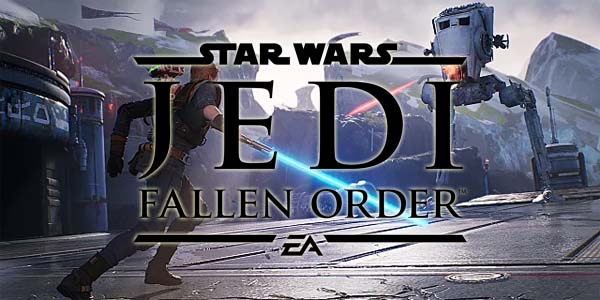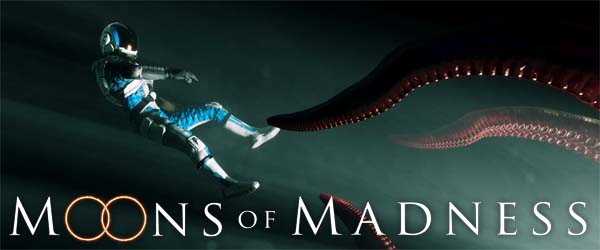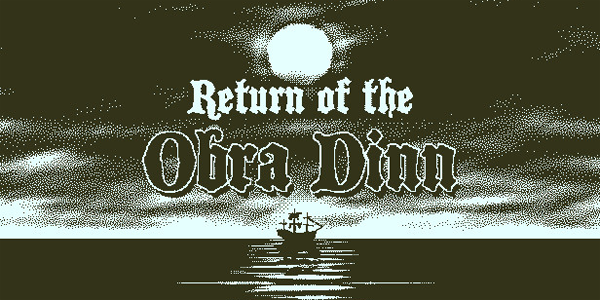
Jedi Fallen Order advertised itself as "Star Wars Dark Souls". In reality though, Fallen Order pulls its inspirations from a hodgepodge of popular gaming trends. Sure, it's borrows a lot from From Software's playbook, but there's also a lot of Uncharted / Prince of Persia, Tomb Raider, "Metroid-vania", Mass Effect, and even a little bit of Breath of the Wild in here too. In fact, I'd even say that it would be more apt to compare Jedi Fallen Order to Sekiro rather than to Dark Souls.
Fallen Order competently executes on all the concepts that it borrows from other games, but it doesn't really do much to separate itself (let alone elevate itself) from those other games, aside from applying the coat of Star Wars paint. The lightsaber play is good, but not nearly as clean as I'd like it to be. The platforming is mostly just an over-complicated way of getting from point A to point B. The RPG-elements are shallow. The puzzles aren't particularly taxing, and mostly just come down to whether or not you notice all the things in the chamber that you're supposed to interact with. And the narrative and characters are passable, but nothing to write home about.
Concepts are borrowed liberally from Dark Souls, Uncharted, Mass Effect, Breath of the Wild, and more.
Pick your poison
It's a good thing, then, that Fallen Order isn't nearly as demanding as Dark Souls or Sekiro. If it had been, then the lack of polish and creativity would have undoubtedly turned me off of the game entirely. And if those didn't kill the game for me, the long load times would. Remember how awful Bloodborne was at launch? Dying every few minutes, and then sitting through a minute or more of load times. Fallen Order is about that bad. But at least Bloodborne got a patch a few weeks after release that shortened the load times to a tolerable 30 seconds or less. I'm playing Fallen Order four months after release, and no such patch has been released for this game yet.
You know exactly what effects each
difficulty setting will have on the game.
Thankfully, the difficulty curve here is much more comfortable, and I'm not finding myself repeatedly dying nearly as often as I did in Bloodborne. And if I were, this game allows me to adjust the difficulty level mid-game if I get stuck -- which I did do on two occasions. The game is even kind enough to tell me what specific effects each difficulty setting has on the game. I kind of wish they had just allowed us to custom tweak each of the three difficulty sliders on our own to further customize our experience, but oh well. Something for the PC modders to do, I guess.
The hero, Cal, can take a handful of hits before dying, and checkpoints are liberally sprinkled throughout the maps. Very few enemies are huge damage sponges, and even the ones that are good at blocking attacks can usually have their health quickly depleted by side-stepping their attacks and hitting them once or twice in the back.
... [More]

It's hard to make a good Lovecraftian horror game. The key to Lovecraft's horror was the mysterious intractability of his cosmic abominations. It wasn't just that they were ugly or deadly; the horror came from the realization that these monsters were part of a much greater cosmos that humans can barely comprehend, and that we are little more than ants to these god-like beings who could snuff us out of existence at a whim -- if they even cared enough about us to do so. In the century since Lovecraft wrote his stories, Lovecraft's monsters have become so iconic that Cthulhu is pretty much a universally-recognized, cliche monster along with the likes of Dracula and the Xenomorph. The closer a story adheres to Lovecraft's ideas, the more familiar it becomes, and the harder it is to create that sense of being overwhelmed with unfathomable knowledge that drives a person insane.
That is why I think that FromSoftware's Bloodborne is perhaps the best video game adaptation of Lovecraft's concepts (even though it is not a direct adaptation of any of his stories). Bloodborne's esoteric and arcane lore, and the indirect nature in which it communicates its backstory, actually does create that sense that the player is just a small piece of a much larger puzzle that you will never fully comprehend. And the difficult nature of the game means that the player certainly feels like you can be snuffed out of existence at any moment.
Moons of Madness isn't mysterious, or arcane, or particularly threatening. It's cliche and predictable to a fault.
Flatline
I saw almost every plot point coming from a mile away, and if you don't want spoilers, then I suggest you skip ahead to the next section. I didn't expect there to be a full-on underground lab complex akin to Resident Evil 2, but it wasn't something that came off as very surprising considering how telegraphed the corporate conspiracy "twist" was from the start. All the other twists, however, came off as rote and stale. The science experiment gone haywire, the relief ship crashing, the reveals about the protagonist's family history, the multiple betrayals ... none of it came off as even remotely surprising, and the whole game degraded to simply waiting for the next shoe to drop. The game isn't very long, but the predictable nature of its plot made it feel like it was dragging on for much longer than its six-ish hour playtime.
The secret lab was not a surprise and only distracted from the cosmic horror.
Worse yet, the corporate conspiracy stuff ended up distracting from, and drowning out, the Lovecraftian cosmic horror. The monsters don't feel mysterious because they're all the results of experiments being done at the request of the evil corporation. The Lovecraftian temple complex and "dreamers" fall flat because their existence is spoiled much earlier in the game. Heck, the other characters visit the temple and tell you all about it over the radio, while you're fumbling about the silly underground lab, so by the time you get to the temple, it's not mysterious at all. I think the point was to try to convey the awe and wonder of the NPC characters in the hopes that it would instill a sense of awe and wonder within the player, but all I could think was "I'd much rather be playing as those other characters right now!"
When all is said and done, I feel like Observation (despite not being directly inspired by Lovecraft's mythos) pulls off the cosmic horror shtick much better because its alien influences remain mysterious and intractable all the way through the end -- perhaps to that game's fault.
... [More]
942aeb04-c29d-447b-8525-5e4dcfd19326|0|.0
Tags:Moons of Madness, Steam, Rock Pocket Games, Dreamloop Games, Funcom, science fiction, horror, cosmic horror, H.P. Lovecraft, walking simulator, Mars, conspiracy

I had no clue what to expect from Death Stranding. I probably would have bought it regardless because I usually enjoy Kojima's games. I was also curious if Death Stranding would be, in some way, representative of what the canceled Silent Hills might have been. Most of all, Kojima is a bold, and usually innovative creator, and I felt compelled to support his new studio -- if for nothing else than to give a middle finger to Konami.
After spending several dozen hours with it, I'm still not really sure what to think of Death Stranding. Much like with Final Fantasy XV, Death Stranding is loaded with novel ideas and messages that I find personally interesting or compelling. But just like Final Fantasy XV, those novel ideas take a back seat to time-wasting filler quests. Death Stranding can be hypnotically beautiful, zen-like, and maybe even emotionally moving, but it's also big, bloated, and convoluted, and it takes far too long to get where it's going.
At a very reductionist level, Death Stranding could be accurately characterized as "side quest: the game" or "Amazon courier: the game". But that characterization would be overlooking the nuance behind the game, and what it has to say about modern gaming and society in general. That makes it a very difficult game to review without giving one's self some time to let it soak in ... which is part of the reason why I've been mulling it over for more than a month now...
Rebuilding America, one Amazon delivery at a time
Carrying cargo is, in fact, the entire game! Our protagonist, Sam, is unwittingly tasked with delivering cargo across this post-apocalyptic America in an attempt to get in the good graces of the settlements dotting the land, and connect them all up to a vast information network to restore a semblance of civilization. On the way, you can literally build roads and bridges as you go -- rebuilding the American infrastructure little by little.
Online players will leave guideposts and infrastructure to help each other out.
This infrastructure is actually a clever implementation of the Demon's Souls / Dark Souls style of asynchronous multiplayer. In principle.
Instead of the ghostly visages of other player warning you of traps or ambushes or pitfalls, online players can build bridges, roads, vehicle charging stations, storage boxes, and other helpful infrastructure that will make your trek through the world legitimately easier. They aren't just cluing you in about what dangers to expect, or what course of action to take, the other players are actively helping you (and everyone else) without ever needing to set a digital foot in your game. Just like in FromSoft's Souls games, you can also leave little notes that take the form of emoticons, and which combine the function of the Souls player messages with avatar gestures.
When you first step out into the world, there's a sense of desolation and loneliness about the landscape. It reminds me a lot of Shadow of the Colossus, except our only company is a crying fetus instead of Aggro (who's such a good horsey!). The scenery itself is more evocative of Iceland, and doesn't look like any part of the United States that I've ever been. But then again, this is the same game designer who put a tropical rainforest in the middle of Soviet Russia, so... It's beautiful and serene, and figuring out how you're going to navigate the environment can be a legitimate zen-like puzzle.
Trekking through the map reminded me of the beautifully desolate environments of Shadow of the Colossus.
This game requires very precise and deliberate inputs from the player, and it can sometimes be very unforgiving of small mistakes. If you turn too quickly, Sam may lose his balance and fall over, possibly damaging or destroying the packages that you are carrying. Walk to quickly down a steep slope, and you'll risk loosing your footing and face-planting. You can hold one or both trigger buttons to try to stabilize yourself or catch your balance -- and there's no real reason to not hold both triggers the entire game, since balancing your load doesn't make Sam walk noticeably slower. And you'll have to manage Sam's stamina, the battery supply of vehicles or certain tools, and so forth. You might even find your hands cramping from holding down the triggers after a particularly long or strenuous journey over rough terrain, providing you with a small degree of physical discomfort to go along with Sam's physical exhaustion. And you'll be pushed along by occasional rainfall that will cumulatively damage your cargo and equipment.
Even though Sam will progressively get stronger and better able to keep himself balanced, and even though the game will gradually unlock new mechanics for making it easier to traverse the landscape, you can never get sloppy, and the game will punish you for impatience! It reminds me a lot of Dark Souls, except instead of getting killed by a hollow undead sword flurry because I thought I could sprint through a return trip through an early area of the game, I'm instead tripping over my own two feet because I tried to run down a mossy slope to get this delivery done faster.
Simply navigating the open world terrain without tripping and falling is a primary gameplay mechanic.
The terrain is important and relevant, and navigating it safely and efficiently is the game's core gameplay. You aren't simply holding the stick forward and walking a straight line to a point on the mini-map or radar, as you might do in, say, Skyrim or Far Cry. This is how you design an open world game! You make the traversal of the space into the operant challenge. Or, at the very least, make the space between landmarks -- and the act of traversing that space -- feel meaningful. I feel like game designers are really starting to vindicate all those blogs that I wrote years ago about the failings of open world design. The destinations aren't important in Death Stranding. It's the space in between (the open world itself) that is important.
... [More]
b05094b6-4edc-4826-a70a-dd41aa427e42|3|5.0
Tags:Death Stranding, Hideo Kojima, Kojima Productions, Norman Reedus, Guillermo del Toro, Mads Mikkelsen, Lea Seydoux, Tommie Earl Jenkins, post-apocalypse, open world, Amazon, Twitter, porter, hiking, backpacking, camping, infrastructure, asynchronous multiplayer, cooperation

Well, with a Madden review in my rear view mirror, and while waiting for the indie football games to hit the market, I decided to try out one of last year's darling indie games. I very much enjoyed Lucas Pope's previous game, Papers, Please, so Return of the Obra Dinn was high up on my wish list of indie games. It was just a matter of finding time to sit down and play it and give it my full attention.
This isn't a game that you can just kind of casually play. Much like with Papers, Please, Return of the Obra Dinn requires your close attention. You have to pay very close attention to details, which can come from one of several different places. It might be a single word or a name in a snippet of dialogue. It might be inferring a person's naval rank based on the uniform they're wearing. It might be making a mental note of what room a person is running into or out of. You then have to use those details to make genuine deductions or judgement calls.
Elementary, my dear time-lord
The basic premise is that you are an insurance claims adjuster (I guess) working for the English East India Company. A missing merchant ship suddenly returns with all hands missing. You must search the ship to piece together the events of its voyage, and try to determine what happened to as many of the crew as possible.
Search a derelict ship for clues to the fates or whereabouts of its crew and passengers.
Your only tools are a notebook and a mysterious stopwatch (or is it a compass?). The notebook contains a crew manifest, a drawing of all the crew and passengers, a map of the ship, and a few notes on where to look for initial clues. It is also used to log all of the pertinent information that you find. The other tool is the mysterious stopwatch that has the ability to manifest a recreation of the scene of a corpse's death. Where such a fantastical tool came from and why you have it is not really explained (at least not at first). When you find a body, you can activate the stopwatch to see how that person died. The stopwatch manifests a 3-D freeze frame of the moment of the person's death and replays the last things the person heard before he (or she) died.
The whole game consists of exploring these scenes to try to figure out who the deceased person is, how they died, and to cross-reference the scenes to figure out who everyone else is and what happened to them. It's actually a lot more challenging that it seems.
Try to figure out the names and fates of as many people as you can, using the clues provided to you.
... [More]
96628e56-3f20-4c71-b310-e6d59171de54|1|5.0
Tags:Return of the Obra Dinn, Lucas Pope, mystery, noire, point-and-click, walking simulator, indie gaming, stippling, Memento Mortem, sailing, mutiny, insurance

Well, the football video game price wars have apparently begun. Unfortunately, however, the prices are not shifting in the direction I'd like. Instead of EA being forced by competition to drop the price of Madden to something reasonable, like $30 (as they had to do in 2004 to compete with ESPN NFL 2k5's budget price of $20), both Maximum Football 19 and Axis Football 19 have upped their price from $20 (in 2018) to $30 (in 2019). I've already complained that Maximum has shifted its retail price out of the budget indie tier and into the middle-market (or "double-A" tier), and that Maximum isn't quite up to the level of quality that I might expect from a title at that price.
Axis Football doesn't feel quite as over-priced, as it was a much more feature-complete product to begin with (and remains a more feature-complete product this year, despite Maximum's new dynasty mode). That being said, I don't feel that Axis is improved enough to warrant a 50% jump in price.
Whereas Maximum focused on adding a much-needed dynasty mode in order to prop up its mediocre-at-best on-field gameplay (and moderately succeeds in that regard), Axis already had a working Franchise mode. What Axis needed was to improve its on-field gameplay. ...But they kinda didn't... Like, not at all...
Same as last year?
I was optimistic about Maximum Football and Axis Football because I expected them to make significant improvements to on-field gameplay from year-to-year -- something that EA has consistently failed to do with Madden over the last ten-to-fifteen years. So to see both of these indie games play virtually identical to last year's counterparts is very disappointing and has substantially deflated my initial optimism.
My excitement for the potential improvement of Maximum and Axis has been deflated
by both games releasing with virtually identical on-field gameplay compared to last year.
If you read the gameplay section of last year's review, then you pretty much know how this yea'rs game plays. Axis Football 19 still has much of the same rigid and robotic player animations. The locomotion system is terrible and allows runners to cut and turn on a dime. Defensive players still frequently stand in place. Deep zone coverage is still atrocious. The CPU still never defends 2-point conversion attempts. Receivers still lack varied or convincing catch animations, and defenders similarly lack pass defense animations. Blocking and tackle interactions can still be triggered with players who are not in physical contact with each other. I can still run my defensive end around offensive tackles, unblocked, for free sacks.
Some football rules are also still wrong or not implemented at all. Axis might as well just end games in ties if they can't implement a working overtime ruleset. I can still exploit kicking kickoffs out of bounds without penalty in order to pin opposing offenses deep. There's no fair catch. I can't motion receivers before the snap to see if the defense is in man or zone coverage.
The developers failed to address many of the problems that plagued last year's game --
such as poor deep zone coverage [LEFT] and the ability to easily run around offensive tackles [RIGHT].
Much moreso than last year, I'm noticing that outside runs seem to be far too effective. The reason for this seems to be the crazy success rates of receivers making (and holding) blocks on the edge and in the second level. Safeties are not only bad at deep coverage, but they're also terrible in run support. They stay back too deep (and sometimes just stand around), instead of trying to meet the runner in the lanes or trying to force an outside run back inside. If a receiver or tight end gets into the second level and blocks the safety, then the play is practically a guaranteed touchdown.
... [More]
ceb12b50-2cc7-47c4-93ac-b24eda79b3d1|1|5.0
Tags:Axis Football, Axis Football 19, football, Steam, indie gaming, Terry McGovern, Jay Styne, Dan Stevens, Dave Stevens, Peter O'Keefe, Mike Steele, franchise, coach, practice, practice squad, draft, scouting, contract, safety, coverage
|

| 12 | | | | | | | 60 | | 11 | | | | | | | 55 | | 10 | | | | | | | 50 | | 09 | | | | | | | 45 | | 08 | | | | | | | 40 | | 07 | | | | | | | 35 | | 06 | | | | | | | 30 | | 05 | | | | | | | 25 | | 04 | | | | | | | 20 | | 03 | | | | | | | 15 | | 02 | | | | | | | 10 | | 01 | | | | | | | 05 |
|